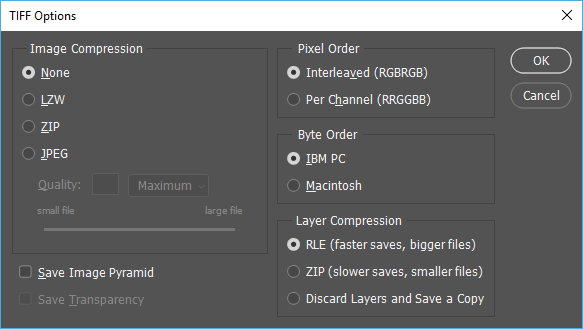- Home
- Photoshop ecosystem
- Discussions
- TIFF file over 4GB - print project
- TIFF file over 4GB - print project
TIFF file over 4GB - print project
Copy link to clipboard
Copied
Hey guys! Few minutes ago I finished project ready to print. I have to save files for printing house, and I have small problem. Enabled fIles extensions are: TIFF, raw, jps, jpg, mpo, psb. I need TIFF but there is a limit =4GB. My project is bigger. Is the any way to save bigger files in TIFF? If not the best extension will be...? JPG?
Explore related tutorials & articles
Copy link to clipboard
Copied
That’s a design limit of TIFF. Your file is extraordinarily large so ask the printing house. Don’t try to second guess them. They might want PSB or insist you make it smaller or something else.
Copy link to clipboard
Copied
Tiff file format supports data compression and can save a flattened version without layers. Have you tried all the data compression options available to see if any will save under 4GB

Reduce to 8 Bit Color if 16 bit color to cut the size in half. Also 8 Bit color can use Jpeg compression however its a lossy compression your image will loose much quality below quality 10.
Most Printers only support 8bit color....
Copy link to clipboard
Copied
Copy link to clipboard
Copied
Hi,
JJMack is right if you select discard Layers under Layer Compression under the Layer Compression options that should decrease your file size considerably.
Copy link to clipboard
Copied
Just to get it out of the way: a file in excess of 4GB is enormous, much larger than anyone would normally ever need.
You don't need 300ppi for large format prints. The larger, the lower the ppi. In fact, a wall-sized banner needs about the same amount of pixels as a magazine spread. The pixels are just printed bigger.
So the point is - is this for some very special purpose, or are you just making a banner / billboard for normal viewing distance? If the latter this is overkill and wasted.
Copy link to clipboard
Copied
Perhaps a large stitched panorama may have that much pixel detail Paris 26 Gigapixels - Interactive virtual tour of the most beautiful monuments of Paris needs a huge print to be examined close up to see the intermit details. More that 2000 stitched photos. Yes not normal...
Copy link to clipboard
Copied
Yes, I know that, I've made 7GB files. The point is that a lot of people out there believe anything for print has to be 300ppi regardless of size. We've had three or four here only in the last week or so.
Copy link to clipboard
Copied
Yes viewing distance can reduce the number of pixels you need greatly for an acceptable image for a billboard. Still a 8bit color 26Gigapixel image would be 78GB of pixel data before compression. You do not need 26Gigapixels for a billboard print you would discard almost all the details you have for yourimage for a billboard print for your your billboard scenic view of paris. You need to resample your image.....
Copy link to clipboard
Copied
In case of fabric printing you do need 300 dpi and even 600 dpi
Copy link to clipboard
Copied
I can't believe fabric can resolve 300 pixels per inch. How many threads per inch in the fabric?
I'd think 75 ppi is a more realistic number.
Copy link to clipboard
Copied
Hi guys, I have used PhotoZoom pro to increase dpi after I have saved it in Tiff format with smaller dpi and app uses intelligent math algorithms to increase the overall quality of the image
Copy link to clipboard
Copied
Are you certain this workflow increases the quality of the image?
By the way, the correct terminology for this is PPI, not DPI which is the term for printer resolution (not to be confused with LPI which is used for half-tone resolution)
The inconvenience of the increased size of TIFF files, for an imperceptible increase in quality, IMO makes lightly compressed (say 10) JPGs a preferred format for saving and distributing images in almost all scenarios.
Copy link to clipboard
Copied
Whats your question please?
And why did you need to do that? What is the image use to be?
"app uses intelligent math algorithms to increase the overall quality of the image"
it would HAVE to be intelligent as it's making up detail.
I hope this helps
thanks
neil barstow, colourmanagement.net :: adobe forum volunteer
[please do not use the reply button on a message within the thread, only use the blue reply button at the top of the page, this maintains the original thread title and chronological order of posts]
Copy link to clipboard
Copied
A few notes on Jpeg:
Jpeg files have compression applied, changing resolution or cropping and re-saving enhances the compression artifacts - this means that Jpeg is only really suitable for final file delivery/transfer - with the Jpeg created only once size and resolution (and any sharpening) have been completed.
So, Jpeg is far from ideal for editing and not OK for archiving or for any file that may need to be resaved, resized or cropped down the line.
Jpeg is the worst possible format if you want to keep high quality - you should always archive a copy of your original, ideally with any adjustment layers intact - if you work with layers.
Jpeg compression (at any setting*) really is "lossy”, irreversible, and cumulative, so Jpegs should ONLY be used only for final delivery and only created from the original file format AFTER resizing & cropping to the FINAL size and crop.
To explain: any edits to size or crop, or even just re-saving a Jpeg file means further compression, potentially that’s very damaging.
The JPEG compression damage is not always immediately apparent, which is perhaps why it's still widely used - however, that compression will soon cause issues if you do further work and save again. That’s when you’ll see a Jpeg with some real issues.
*don’t imagine that selecting maximum quality for your Jpeg is preserving the original data, it’s still compressing a lot which discards information.
SO, don’t reuse Jpegs if any resizing or resaving is needed. Always go back to the PSD/ Tiff originals, Jpegs are essentially a 'use once and trash' file type.
I hope this helps
I hope this helps
neil barstow, colourmanagement net - adobe forum volunteer - co-author: 'getting colour right'
google me "neil barstow colourmanagement" for lots of free articles on colour management
Help others by clicking "Correct Answer" if the question is answered.
Found the answer elsewhere? Share it here. "Upvote" is for useful posts.
Get ready! An upgraded Adobe Community experience is coming in January.
Learn more


